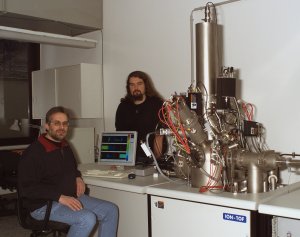
Dr. Thomas Stephan and Jan Leitner use this equipment to study the comet dust from NASA in a laboratory at the Institute of Planetology Foto: WWU
Münster (upm), 20. Dezember 2006

Stardust is the first space mission which has brought back to earth solid material from a celestial body other than the moon - thousands of dust particles from the Wild 2 comet, which the NASA probe visited in 2004. After the Stardust capsule had successful landed in the Utah desert on 15 January 2006, the comet samples were studied by an international team of around 175 scientists worldwide. The first results have now been presented in seven articles, published on 15 December 2006 in the acclaimed US magazine Science.
Dr. Thomas Stephan from the Institute of Planetology at the University of Münster (WWU) is involved in the work, as is his PhD student Jan Leitner. Stephan is in four of the six international teams which have been studying the various properties of the comet dust and is the co-author of five of the articles in Science. In his work he has been using a technology which was developed at WWU's Insitute of Physics and is marketed worldwide by the Münster company ION-TOF.
Stephan has made it possible to use this technology in planetology through his work in the past. Using so-called time-of-flight secondary ion mass spectrometry it was possible to study the elemental, isotopic, organic and, in part, also the mineralogical composition of the comet dust.
The initial results now published in Science have drastically changed our picture of comets, providing remarkable insights into the origin of comets and into how the solar system came into being. Before now, it had been assumed that comets were isolated from the processes of the internal solar system, in other words from the region in which the Earth, for example, was formed.
Instead, comets must have been dominated by tiny dust particles formed in the vicinity of other stars or in interstellar space. The big surprise now was that most of the Wild 2 material was formed in the vicinity of the sun. In contrast to predictions made on the basis of astronomical observations, these comet particles consist predominantly of crystalline material. This includes minerals which were formed at temperatures probably above 1700°C.
Whereas comets have previously been characterised as cold objects because of the frozen water inside them, minerals have now also been found which were formed at high temperatures - a mixture of fire and ice. The components of the comet come from both the hottest and the coldest regions of the solar system. This means that in the early solar system material must have been transported from inside Mercury's orbit to the outer regions beyond Neptune and Pluto.
The results from Münster were important for this new picture of comets. Among other things, they showed that on the one hand the comet dust has an extremely heterogeneous structure in its detail - i.e. it consists of numerous tiny mineral particles (often smaller than one-thousandth of a millimetre) with a wide variety of elemental ratios. On the other hand, the results also showed that the comet as a whole has the same chemical composition as our solar system. Despite these impressive first results, work on studying the stardust samples is still at an early stage. The comet dust - of which well below 10 percent has been studied so far - will be keeping planetologists busy worldwide for years to come.